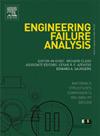基于纵向动刚度的公路桥梁双柱墩损伤快速识别方法
IF 5.7
2区 工程技术
Q1 ENGINEERING, MECHANICAL
引用次数: 0
摘要
双柱墩作为一种重要的承重构件,是公路桥梁下部结构中最常见的形式之一。随着交通运输量的不断增长和自然灾害的发生,双柱墩极易受到破坏,有效的损伤识别对其长期安全使用至关重要。传统的损伤识别方法通常依赖于目视检测和无损检测,通常侧重于对表面损伤的检测,无法实现定量评估。针对这些问题,本文提出了一种基于纵向动刚度的公路双柱桥墩损伤快速识别方法。首先,提出动力指标,实现对破损桥墩的初步判断;其次,引入动刚度相似系数和动刚度对数差值来识别桥墩的损伤部位和具体损伤位置;最后,利用贝叶斯优化的k近邻分类器实现损伤量化。通过某公路桥双柱墩的比例模型试验,验证了该方法的有效性和准确性。结果表明,该方法能准确地定位和量化双柱墩的损伤,识别结果与比例模型试验中的预估损伤吻合较好。该方法可为实际工程中公路桥梁双柱墩的损伤识别和快速评估提供参考。本文章由计算机程序翻译,如有差异,请以英文原文为准。
A rapid damage identification method for highway bridge double-column piers based on longitudinal dynamic stiffness
As a vital load-bearing component, double-column pier is one of the most prevalent types in highway bridges substructures. With the continuous growth of traffic volume and the occurrence of natural disasters, double-column piers are highly susceptible to damage and effective damage identification is crucial to their long-term service safety. Conventional damage identification methods usually depend on visual inspection and non-destructive testing, typically focus on the inspection of surface damage and cannot achieve quantitative assessments. To address these challenges, this paper proposes a rapid damage identification method for highway double-column piers utilizing longitudinal dynamic stiffness. Firstly, the dynamic index is proposed to achieve the preliminary judgement of the damaged pier. Secondly, the dynamic stiffness similarity coefficient and logarithmic difference of dynamic stiffness are introduced to identify the damage side and the specific damaged location of the pier. Finally, the Bayesian-optimized K-nearest neighbor classifier is used to achieve the damage quantification. The effectiveness and accuracy of the proposed method is validated through a scale model experiment of a highway bridge double-column pier. The results demonstrate that the proposed methodology can accurately locate and quantify the damage of double-column piers, and the identification results agree well with the preset damage in the scale model experiment. The proposed method can provide reference for damage identification and rapid evaluation of highway bridge double-column piers in actual engineering.
求助全文
通过发布文献求助,成功后即可免费获取论文全文。
去求助
来源期刊

Engineering Failure Analysis
工程技术-材料科学:表征与测试
CiteScore
7.70
自引率
20.00%
发文量
956
审稿时长
47 days
期刊介绍:
Engineering Failure Analysis publishes research papers describing the analysis of engineering failures and related studies.
Papers relating to the structure, properties and behaviour of engineering materials are encouraged, particularly those which also involve the detailed application of materials parameters to problems in engineering structures, components and design. In addition to the area of materials engineering, the interacting fields of mechanical, manufacturing, aeronautical, civil, chemical, corrosion and design engineering are considered relevant. Activity should be directed at analysing engineering failures and carrying out research to help reduce the incidences of failures and to extend the operating horizons of engineering materials.
Emphasis is placed on the mechanical properties of materials and their behaviour when influenced by structure, process and environment. Metallic, polymeric, ceramic and natural materials are all included and the application of these materials to real engineering situations should be emphasised. The use of a case-study based approach is also encouraged.
Engineering Failure Analysis provides essential reference material and critical feedback into the design process thereby contributing to the prevention of engineering failures in the future. All submissions will be subject to peer review from leading experts in the field.
 求助内容:
求助内容: 应助结果提醒方式:
应助结果提醒方式:


